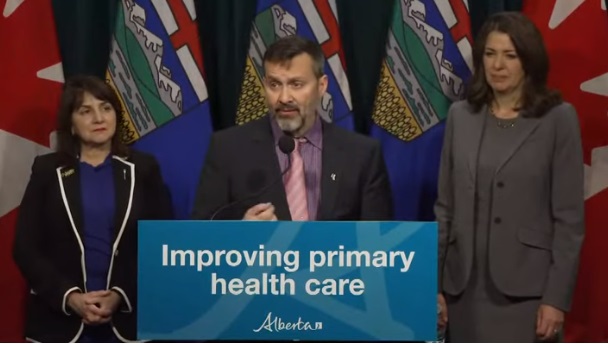Alberta
Massive funding boosts kick off Alberta’s transition to fully comprehensive care

Dr. Paul Parks, president, Alberta Medical Association
Canada signs more than $1 billion bilateral agreement with Alberta to improve health care over three years
From: Health Canada
This investment will increase access to a primary health provider, reduce wait times for mental health services, and provide greater access to health data.
Canadians want and deserve a health care system that provides timely access to health services whenever and wherever they are needed. That is why the Government of Canada is investing over $200 billion over 10 years, which includes $25 billion for tailored bilateral agreements with provinces and territories, to support the Working Together to Improve Health Care for Canadians plan.
Today, the Honourable Mark Holland, Canada’s Minister of Health, and the Honourable Adriana LaGrange, Alberta Minister of Health, announced a bilateral agreement to invest $1.06 billion over the next three years, marking a crucial step in a 10-year plan for collaboration. This includes $285 million per year in new funding by the Government of Canada and continuing $70 million per year in previously-announced mental health and substance use funding, which will help accelerate efforts already underway in Alberta to improve health care access and services.
Through this federal funding, Alberta has a three year action plan to deliver improvements to its health care system by 2026, including:
- Increasing access to primary care providers for Albertans and reducing emergency department visits that could have been addressed by a family medicine office. This will be achieved by expanding team-based care and enhancing virtual care, and increasing the number of appointments available to patients.
- Funding community providers to increase diagnostic imaging capacity in the province, reducing wait times for CT scans and MRIs.
- Improving patient care by enhancing Albertans’ ability to access digital health services and their own health information by implementing e-referral services and accelerating the secure exchange of data across the health system.
- Expanding integrated services for youth mental health services in the province through school-based and community day programs, and offering more supports for youth with complex needs as they transition into adult services.
- Reducing median wait times for community mental health and substance use services by establishing new and improving existing treatment spaces, along with prioritizing culturally appropriate Indigenous community supports.
- Ensuring that First Nations and Métis people have access to high-quality, culturally safe care that meets their unique health needs. This will be achieved through dedicated funding for initiatives to enhance access to primary care in Indigenous communities, and funding for communities to develop health workforce capacity and infrastructure to improve the collection and use of health information and data.
- Improving access to health care for underserved Albertans, including through expanded community pilots that bring testing services to rural, remote and Indigenous communities, advancing French-language health services, and greater clinical care for women.
Progress on these initiatives and broader commitments will be measured against targets which Alberta will publicly report on annually.
Through this new agreement, Alberta will improve how health information is collected, shared, used and reported to Canadians; streamline foreign credential recognition for internationally educated health professionals; facilitate the mobility of key health professionals within Canada; and fulfill shared responsibilities to uphold the Canada Health Act to protect Canadians’ access to health care that is based on need, not the ability to pay.
Recognizing the significant disparities in Indigenous health outcomes, the Government of Canada and the Government of Alberta also commit to meaningfully engage and work together with Indigenous partners to support improved access to quality and culturally appropriate health care services. Alberta’s action plan is informed by continued engagement with its Indigenous partners and recent discussions involving the federal government. All orders of government will approach health decisions in their respective jurisdictions through a lens that promotes respect and reconciliation with Indigenous Peoples.
Alberta and the federal government will continue working together to improve access to health services and deliver tangible results to all residents across the province, including responding to the needs of Indigenous and other underserved and disadvantaged populations.
Quotes
“Our government is working together with provinces and territories to get Canadians the healthcare they need. This agreement is an important step in our collaboration with Alberta to take measurable actions to transform our health care system. The funding will help improve access to primary care and create better mental health services in Alberta. Together, we will continue working to achieve better health outcomes for all Canadians.”
The Honourable Mark Holland
Minister of Health of Canada
“Mental health is health, and through this agreement, we will be working with Alberta to integrate mental health and substance use care as a full and equal part of our universal health care system. This agreement will strengthen the capacity of family health providers, reduce substance use harms, and expand virtual care for youth to improve access to quality and timely mental health care and substance use supports. Together, we must ensure that all Canadians have access to supports and services for their mental health and well-being – when they need them, wherever they need them.”
The Honourable Ya’ara Saks
Minister of Mental Health and Addictions and Associate Minister of Health of Canada
“Alberta’s government is taking a serious look at the way health care is being delivered in our province. This is why we are refocusing our health care system to ensure Albertans have access to timely care, when and where they need it. This initial funding from the federal government is a good start and will support our shared health priorities of expanding access to primary care across the province and especially in our Indigenous communities, supporting our health care workers, improving access to quality mental health, and modernizing our health systems.”
The Honourable Adriana LaGrange
Minister of Health of Alberta
“Alberta’s government is supporting Albertans to improve their mental health and recover from the deadly disease of addiction as we build out the Alberta Recovery Model and refocus our provincial healthcare system. We are doing this by increasing access to CASA Mental Health Classrooms across the province, building more bed based mental health treatment capacity for youth, and improving access to mental health and addiction treatment services in communities. This initial funding from the federal government will offer some support to these made in Alberta initiatives as we build a better system of mental health and addiction care for Albertans.”
The Honourable Dan Williams
Minister of Mental Health and Addiction of Alberta
Quick facts
- The Working Together investment includes $25 billion for tailored bilateral agreements with provinces and territories, a guaranteed 5% Canada Health Transfer (CHT) increase for the next five years—amounting to $17.5 billion—and a one time CHT $2 billion top-up to address urgent needs of emergency rooms and paediatric hospitals delivered in June 2023. Combined, these investments provide provinces and territories the flexibility to address the unique needs of their populations and geography, and accelerate health care system improvements.
- Budget 2023 outlined the Government of Canada’s plan to invest over $200 billion over 10 years, including $46.2 billion in new funding for provinces and territories, to improve health care for Canadians. Within this funding, $25 billion is allocated through tailored bilateral agreements to address the unique needs of their populations and geography in four shared health priorities:
- expanding access to family health services, including in rural and remote areas;
- supporting health workers and reducing backlogs;
- increasing mental health and substance use support; and
- modernizing health care systems with health data and digital tools.
- All provinces and territories are already making considerable investments to advance progress in all four of these priority areas, and the new federal funding is complementing and expanding those efforts.
- As part of these bilateral agreements, provinces and territories are developing action plans that outline how funds will be spent and how progress will be measured to demonstrate to Canadians that improvements are occurring in Canada’s health care system. Alberta’s initial 3-year Action Plan can be found here.
- Budget 2017 committed $11 billion over 10 years in federal funding to provinces and territories to improve access to home and community care, and mental health and addictions services for Canadians. Bilateral agreements were signed with provinces and territories to access the first six years of funding. The final four years of funding for mental health and addictions are included in the new Working Together bilateral agreements.
- The Government is also working with provinces and territories to implement a second bilateral agreement focused on helping Canadians age with dignity close to home, with access to home care or care in a safe long-term care facility. This agreement will include the remaining $2.4 billion over four years to improve access to home and community care from Budget 2017; and the $3 billion over five years for long-term care from Budget 2021 to apply standards of care in long-term care facilities and help support workforce stability.
———-
From the Province of Alberta
This funding will be an essential transitional step to ensure doctors can continue to provide this care as we rapidly transition to a funding model that supports fully comprehensive care.”
Dr. Paul Parks, president, Alberta Medical Association
New funding to stabilize primary health careStabilization funding is coming soon as Alberta’s government continues working to improve primary health care across the province. The government is pulling out all the stops to stabilize, strengthen and improve Alberta’s primary health care system. Additional funding of $200 million over two years will improve access to family physicians and help ensure primary health care is available for every Albertan when and where they need it. This funding is enabled through the new Canada-Alberta Health Funding Agreement with the federal government. The agreement represents a total of approximately $1.1 billion in additional health care funding over three years for shared priorities.
Stabilization funding is an important transitional measure identified through work under the memorandum of understanding (MOU) between the minister of health and the Alberta Medical Association (AMA), signed earlier this fall. The AMA has been advocating for family physicians and rural generalists through its work under the MOU. Alberta’s government will continue to engage with the AMA as it works to develop a new, sustainable physician comprehensive care model, which will also dictate how this additional funding will be distributed. In addition to work between the government and the AMA, the Comprehensive Care Task Force will, in the new year, provide a first draft of recommendations that will include additional short-term stabilization actions to help family doctors continue to practise comprehensive care and bridge the gap until a new physician comprehensive care model is developed. These short-term actions will:
Alberta’s government is committed to finalizing a sustainable physician comprehensive care model that will address the concerns of family physicians and rural generalists and ensure Albertans can access the care they need.
Other recently announced supports for primary health care include:
Related information |
Alberta
Alberta’s huge oil sands reserves dwarf U.S. shale

From the Canadian Energy Centre
By Will Gibson
Oil sands could maintain current production rates for more than 140 years
Investor interest in Canadian oil producers, primarily in the Alberta oil sands, has picked up, and not only because of expanded export capacity from the Trans Mountain pipeline.
Enverus Intelligence Research says the real draw — and a major factor behind oil sands equities outperforming U.S. peers by about 40 per cent since January 2024 — is the resource Trans Mountain helps unlock.
Alberta’s oil sands contain 167 billion barrels of reserves, nearly four times the volume in the United States.
Today’s oil sands operators hold more than twice the available high-quality resources compared to U.S. shale producers, Enverus reports.
“It’s a huge number — 167 billion barrels — when Alberta only produces about three million barrels a day right now,” said Mike Verney, executive vice-president at McDaniel & Associates, which earlier this year updated the province’s oil and gas reserves on behalf of the Alberta Energy Regulator.
Already fourth in the world, the assessment found Alberta’s oil reserves increased by seven billion barrels.
Verney said the rise in reserves despite record production is in part a result of improved processes and technology.
“Oil sands companies can produce for decades at the same economic threshold as they do today. That’s a great place to be,” said Michael Berger, a senior analyst with Enverus.
BMO Capital Markets estimates that Alberta’s oil sands reserves could maintain current production rates for more than 140 years.
The long-term picture looks different south of the border.
The U.S. Energy Information Administration projects that American production will peak before 2030 and enter a long period of decline.
Having a lasting stable source of supply is important as world oil demand is expected to remain strong for decades to come.
This is particularly true in Asia, the target market for oil exports off Canada’s West Coast.
The International Energy Agency (IEA) projects oil demand in the Asia-Pacific region will go from 35 million barrels per day in 2024 to 41 million barrels per day in 2050.
The growing appeal of Alberta oil in Asian markets shows up not only in expanded Trans Mountain shipments, but also in Canadian crude being “re-exported” from U.S. Gulf Coast terminals.
According to RBN Energy, Asian buyers – primarily in China – are now the main non-U.S. buyers from Trans Mountain, while India dominates purchases of re-exports from the U.S. Gulf Coast. .
BMO said the oil sands offers advantages both in steady supply and lower overall environmental impacts.
“Not only is the resulting stability ideally suited to backfill anticipated declines in world oil supply, but the long-term physical footprint may also be meaningfully lower given large-scale concentrated emissions, high water recycling rates and low well declines,” BMO analysts said.
Alberta
Canada’s New Green Deal

From Resource Works
Nuclear power a key piece of Western Canadian energy transition
Just reading the headlines, Canadians can be forgiven for thinking last week’s historic agreement between Alberta and Ottawa was all about oil and pipelines, and all about Alberta.
It’s much bigger than that.
The memorandum of understanding signed between Canada and Alberta is an ambitious Western Canadian industrial, energy and decarbonization strategy all in one.
The strategy aims to decarbonize the oil and gas sectors through large-scale carbon capture and storage, industrial carbon pricing, methane abatement, industrial electrification, and nuclear power.
It would also provide Canadian “cloud sovereignty” through AI computing power, and would tie B.C. and Saskatchewan into the Alberta dynamo with beefed up power transmission interties.
A new nuclear keystone
Energy Alberta’s Peace River Nuclear Power Project could be a keystone to the strategy.
The MOU sets January 1, 2027 as the date for a new nuclear energy strategy to provide nuclear power “to an interconnected market” by 2050.
Scott Henuset, CEO for Energy Alberta, was pleased to see the nuclear energy strategy included in the MOU.
“We, two years ago, went out on a limb and said we’re going to do this, really believing that this was the path forward, and now we’re seeing everyone coming along that this is the path forward for power in Canada,” he said.
The company proposes to build a four-unit, 4,800-megawatt Candu Monark power plant in Peace River, Alberta. That’s equivalent to four Site C dams worth of power.
The project this year entered a joint review by the Impact Assessment Agency and Canadian Nuclear Safety Commission.
If approved, and all goes to schedule, the first 1,000-MW unit could begin producing power in 2035.
Indigenous consultation and experienced leadership
“I think that having this strategy broadly points to a cleaner energy future, while at the same time recognizing that oil still is going to be a fundamental driver of economies for decades to come,” said Ian Anderson, the former CEO of Trans Mountain Corporation who now serves as an advisor to Energy Alberta.
Energy Alberta is engaged with 37 First Nations and Metis groups in Alberta on the project. Anderson was brought on board to help with indigenous consultation.
While working on the Trans Mountain pipeline expansion, Anderson spent a decade working with more than 60 First Nations in B.C. and Alberta to negotiate impact benefit agreements.
In addition to indigenous consultations, Anderson is also helping out with government relations, and has met with B.C. Energy Minister Adrian Dix, BC Hydro chairman Glen Clark and the head of Powerex to discuss the potential for B.C. beef up interties between the two provinces.
“I’ve done a lot of political work in B.C. over the decade, so it’s a natural place for me to assist,” Anderson said. “Hopefully it doesn’t get distracted by the pipeline debate. They’re two separate agendas and objectives.”
Powering the grid and the neighbours
B.C. is facing a looming shortage of industrial power, to the point where it now plans to ration it.
“We see our project as a backbone to support renewables, support industrial growth, support data centres as well as support larger interties to B.C. which will also strengthen the Canadian grid as a whole,” Henuset said.
Despite all the new power generation B.C. has built and plans to build, industrial demand is expected to far exceed supply. One of the drivers of that future demand is requests for power for AI data centres.
The B.C. government recently announced Bill 31 — the Energy Statutes Amendment Act – which will prioritize mines and LNG plants for industrial power.
Other energy intensive industries, like bitcoin mining, AI data centres and green hydrogen will either be explicitly excluded or put on a power connection wait list.
Beefed up grid connections with Alberta – something that has been discussed for decades – could provide B.C. with a new source of zero-emission power from Alberta, though it might have to loosen its long-standing anti-nuclear power stance.
Energy Minister Adrian Dix was asked in the Legislature this week if B.C. is open to accessing a nuclear-powered grid, and his answer was deflective.
“The member will know that we have been working with Alberta on making improvements to the intertie,” Dix answered. “Alberta has made commitments since 2007 to improve those connections. It has not done so.
“We are fully engaged with the province of Alberta on that question. He’ll also know that we are, under the Clean Electricity Act, not pursuing nuclear opportunities in B.C. and will not be in the future.”
The B.C. NDP government seems to be telling Alberta, “not only do we not want Alberta’s dirty oil, we don’t want any of its clean electricity either.”
Interconnected markets
Meanwhile, BC Hydro’s second quarter report confirms it is still a net importer of electricity, said Barry Penner, chairman of the Energy Futures Initiative.
“We have been buying nuclear power from the United States,” he said. “California has one operating power plant and there’s other nuclear power plants around the western half of the United States.”
In a recent blog post, Penner notes: “BC Hydro had to import power even as 7,291 megawatts of requested electrical service was left waiting in our province.”
If the NDP government wants B.C. to participate in an ambitious Western Canadian energy transition project, it might have to drop its holier-than-thou attitude towards Alberta, oil and nuclear power.
“We’re looking at our project as an Alberta project that has potential to support Western Canada as a whole,” Henuset said.
“We see our project as a backbone to support renewables, support industrial growth, support data centres, as well as support larger interties to B.C., which will also strengthen the Canadian grid as a whole.”
The investment challenge
The strategy that Alberta and Ottawa have laid out is ambitious, and will require tens of billions in investment.
“The question in the market is how much improvement in the regulatory prospects do we need to see in order for capital to be committed to the projects,” Anderson said.
The federal government will need to play a role in derisking the project, as it has done with the new Darlington nuclear project, with financing from the Canada Growth Fund and Canadian Infrastructure Bank.
“There will be avenues of federal support that will help derisk the project for private equity investors, as well as for banks,” Henuset said.
One selling point for the environmental crowd is that a combination of carbon capture and nuclear power could facilitate a blue and green hydrogen industry.
But to really sell this plan to the climate concerned, what is needed is a full assessment of the potential GHG reductions that may accrue from things like nuclear power, CCS, industrial carbon pricing and all of the other measures for decarbonization.
Fortunately, the MOU also scraps greenwashing laws that prevent those sorts of calculations from being done.
Resource Works News
-

 Censorship Industrial Complex2 days ago
Censorship Industrial Complex2 days agoDeath by a thousand clicks – government censorship of Canada’s internet
-

 Daily Caller2 days ago
Daily Caller2 days agoChinese Billionaire Tried To Build US-Born Baby Empire As Overseas Elites Turn To American Surrogates
-

 Great Reset2 days ago
Great Reset2 days agoViral TikTok video shows 7-year-old cuddling great-grandfather before he’s euthanized
-

 Digital ID2 days ago
Digital ID2 days agoCanada releases new digital ID app for personal documents despite privacy concerns
-

 Community2 days ago
Community2 days agoCharitable giving on the decline in Canada
-

 Alberta17 hours ago
Alberta17 hours agoAlberta’s huge oil sands reserves dwarf U.S. shale
-

 Alberta2 days ago
Alberta2 days agoSchools should go back to basics to mitigate effects of AI
-

 Bruce Dowbiggin2 days ago
Bruce Dowbiggin2 days agoNFL Ice Bowls Turn Down The Thermostat on Climate Change Hysteria



